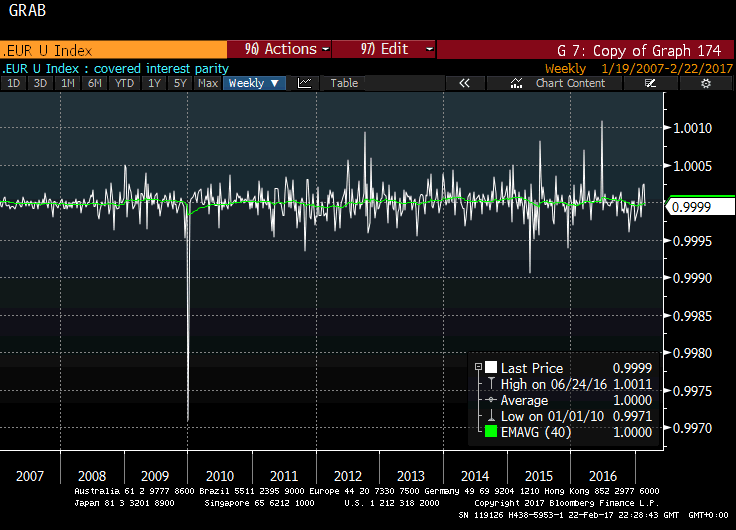Deviations From Covered Interest Rate Parity
I found this report by Wenxin Du, Alexander Tepper and Adrien Verdelhan for the National Bureau of Economic Research to be fascinating and commend it to subscribers. Here is a section:
In this paper, we examine the persistent and systematic failures of the CIP condition in the post crisis period. After formally establishing CIP arbitrage opportunities based on repo rates and KfW bonds, we argue that these arbitrage opportunities can be rationalized by the interaction between costly financial intermediation and international imbalances in funding supply and investment demand across currencies. Consistent with this two-factor hypothesis, we report four empirical characteristics of the CIP deviations. First, CIP deviations increase at the quarter ends post crisis, especially for contracts that appear in banks’ balance sheets. Second, proxies for the banks’ balance sheet costs account for two-thirds of the CIP deviations. Third, CIP deviations co-move with other near-risk-free fixed income spreads. Fourth, CIP deviations are highly correlated with nominal interest rates in the cross section and time series.
Looking beyond our paper, we expect a large literature to investigate further the CIP deviations. The deviations occur in one of the largest and most liquid markets in the world after the crisis in the absence of financial distress, suggesting that other arbitrage opportunities exist elsewhere. While trading in exchange rate derivatives is a zero-sum game, the CIP deviations may have large welfare implications because of the implied deadweight cost borne by firms seeking to hedge their cash flows. Furthermore, the existence of CIP deviation introduces wedges between the interest rates in the cash and swap markets, which affects the external transmission of monetary policy. The welfare cost of the CIP deviation is behind the scope of this paper; it would necessitate a general equilibrium model. Yet, even without such model, the CIP condition is a clean laboratory to test the impact of financial frictions in a very general framework. In this spirit, we present the first international evidence on the causal impact of recent banking regulation on asset prices. We expect more research in this direction in the future.
Here is a link to the full report.
When aberrations appear in what is by definition a zero-sum game it is certainly a topic worthy of further study. This is a subject likely to be of particular interest to large institutional traders where a move of 10s of basis points can be multiplied by weight of money and leverage.
From a wide perspective the fact that arbitrages exist is not particularly comforting because it speaks to both a lack of confidence across sovereign counterparties and large swings in currency markets between jurisdictions which are creating the mismatches.

In order to graphically illustrate the moves I multiplied EUR/USD by USD/EUR. The answer should always be 1 but as we can see from this chart that is not the case and there are a number of occasions when the relationship widens out considerably even on the spot rate.
With so much political risk arising from elections which are likely to be framed as referenda the potential for even more arbitrage opportunities to arise cannot be ignored.


